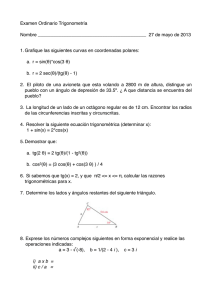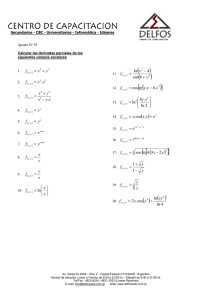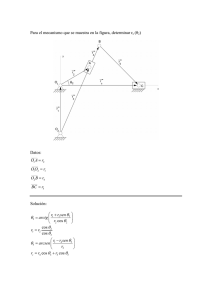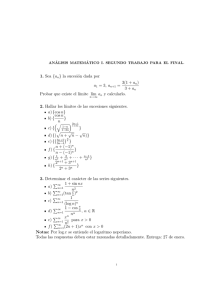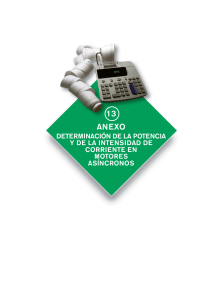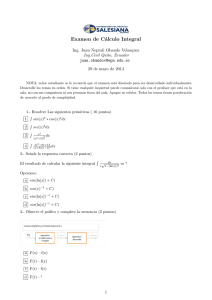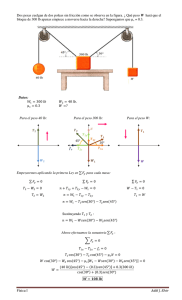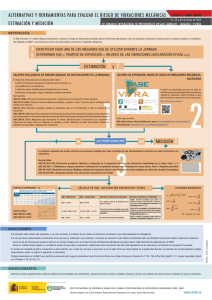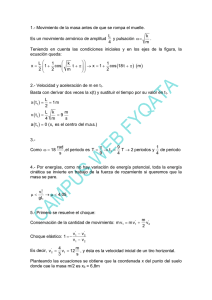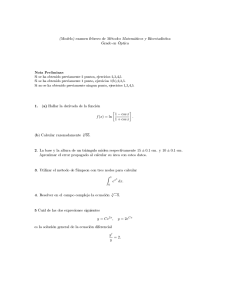MC-2415 Formulario Vibraciones (Compacto)
Anuncio
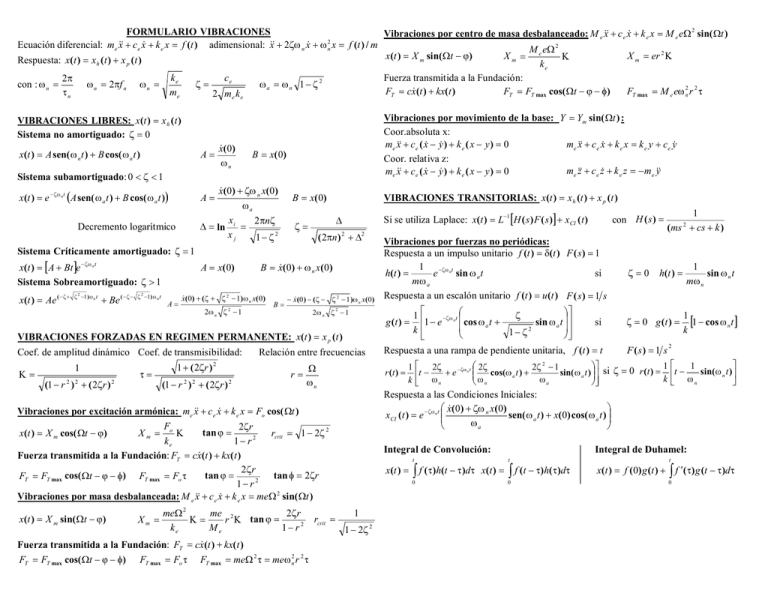
FORMULARIO VIBRACIONES Vibraciones por centro de masa desbalanceado: M e &x& + c e x& + k e x = M e eW 2 sin(Wt ) 2 Ecuación diferencial: me &x& + ce x& + k e x = f (t ) adimensional: &x& + 2zw n x& + w n x = f (t ) / m M e eW 2 X m = er 2 K x ( t ) = X sin( W t j ) X = K m m Respuesta: x(t ) = x h (t ) + x p (t ) ke ke ce Fuerza transmitida a la Fundación: 2p z= con : w n = w n = 2pf n w n = wa = w n 1 - z 2 FT = cx& (t ) + kx(t ) FT = FT max cos(Wt - j - f) FT max = M e ew 2n r 2 t me tn 2 me k e Vibraciones por movimiento de la base: Y = Ym sin( Wt ) : Coor.absoluta x: me &x& + c e ( x& - y& ) + k e ( x - y ) = 0 me &x& + c e x& + k e x = k e y + ce y& Coor. relativa z: me &z& + c e z& + k e z = - me &y& me &x& + c e ( x& - y& ) + k e ( x - y ) = 0 VIBRACIONES LIBRES: x(t ) = x h (t ) Sistema no amortiguado: z = 0 x(t ) = A sen( w n t ) + B cos( w n t ) A= x& (0) wn B = x(0) Sistema subamortiguado: 0 < z < 1 x& (0) + zw n x(0) wa x 2pnz D = ln i = xj 1- z2 x(t ) = e - zw nt ( A sen( w a t ) + B cos( w a t )) A= Decremento logarítmico B = x(0) VIBRACIONES TRANSITORIAS: x(t ) = x h (t ) + x p (t ) Si se utiliza Laplace: x(t ) = L-1 [H ( s ) F ( s )] + xCI (t ) D z= ( 2pn) 2 + D2 Sistema Críticamente amortiguado: z = 1 x(t ) = [A + Bt ]e - zw n t Sistema Sobreamortiguado: z > 1 x(t ) = Ae ( - z + z 2 -1 ) w n t + Be ( - z - z 2 -1 ) w n t A = x(0) A= B = x& (0) + w n x(0) x& (0) + (z + z 2 - 1)w n x( 0) 2 2w n z - 1 B= - x& (0 ) - ( z - z 2 - 1 )w n x( 0) 2w n z 2 - 1 1 (1 - r 2 ) 2 + ( 2zr ) 2 t= 1 + ( 2zr ) 2 (1 - r 2 ) 2 + ( 2zr ) 2 r= W wn Xm = 2z r meW 2 me 2 K= r K tan j = ke Me 1- r2 Fuerza transmitida a la Fundación: FT = cx& (t ) + kx( t ) FT = FT max cos(Wt - j - f) FT max = Fo t FT max = meW 2 t = mew 2n r 2 t rcrit = öù æ 1é z ê1 - e -zw nt ç cos w a t + si sin w a t ÷ú 2 ÷ú ç kê 1 z øû è ë Respuesta a una rampa de pendiente unitaria, f (t ) = t r (t ) = z=0 1 (ms + cs + k ) 2 h(t ) = z = 0 g (t ) = F (s) = 1 s 1 sin w n t mw n 1 [1 - cos w n t ] k 2 é ù 1 sin(w n t )ú êt w n ë û 1 æ 2z öù 1 é 2z 2z 2 - 1 + e - zw n t çç cos(w a t ) + sin( w a t ) ÷÷ú si z = 0 r (t ) = êt k w w k ëê w n a è n øûú Respuesta a las Condiciones Iniciales: æ x&(0) + zw n x(0) ö xCI (t ) = e - zw n t çç sen( w a t ) + x(0) cos( w a t ) ÷÷ w a è ø Vibraciones por excitación armónica: me &x& + c e x& + k e x = Fo cos( Wt ) F 2zr tan j = rcrit = 1 - 2z 2 Xm = o K x(t ) = X m cos( Wt - j) ke 1- r2 Fuerza transmitida a la Fundación: FT = cx& (t ) + kx(t ) 2z r tan j = tan f = 2zr FT = FT max cos(Wt - j - f) FT max = Fo t 1- r2 Vibraciones por masa desbalanceada: M e &x& + c e x& + k e x = meW 2 sin(Wt ) x(t ) = X m sin(Wt - j) Vibraciones por fuerzas no periódicas: Respuesta a un impulso unitario f (t ) = d(t ) F (s) = 1 1 -zw nt h( t ) = e sin w a t si mw a Respuesta a un escalón unitario f (t ) = u (t ) F ( s ) = 1 s g (t ) = VIBRACIONES FORZADAS EN REGIMEN PERMANENTE: x(t ) = x p (t ) Coef. de amplitud dinámico Coef. de transmisibilidad: Relación entre frecuencias K= con H ( s ) = Integral de Convolución: Integral de Duhamel: t t 0 0 x(t ) = ò f ( t )h(t - t )dt x(t ) = ò f (t - t )h(t )dt 1 1 - 2z 2 t x(t ) = f (0) g (t ) + ò f ¢( t) g (t - t )dt 0
